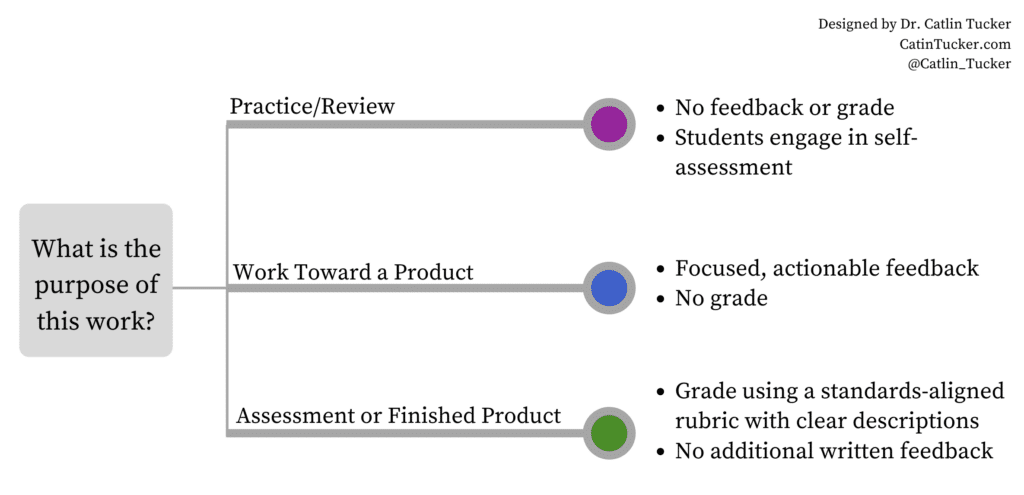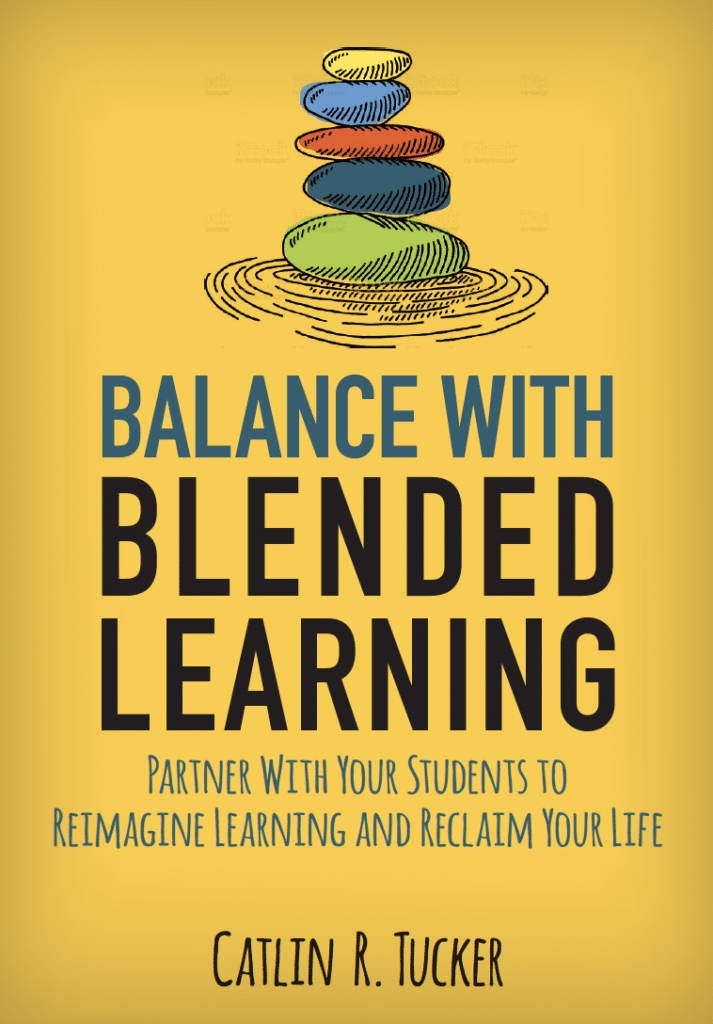[ad_1]
After years of coaching and functioning with academics, there are two points I regularly come across that trigger imbalance in the classroom and over and above.
- Initially, academics shell out important time at the front of the place chatting. The more time teachers devote at the entrance of the room transferring information and orchestrating the lesson, the much less time they have to work together with learners.
- Regular grading techniques rob academics of the time they will need to design and style dynamic classes and retain a healthier perform-daily life balance.
#1 Trainer Discuss is a Barrier to Link
In preceding posts, I have targeted on this very first position by encouraging academics to use blended understanding designs and strategies to free them selves from the entrance of the home. When developing classes where by instructors want to transfer details by means of a mini-lesson or lecture, I inspire them to check with them selves, “Am I heading to say the identical factor to all people?”
- If the answer is “yes,” they need to make a movie and enable learners to self-speed via that instruction. When lecturers use online video to transfer information and facts, they change regulate above the expertise to the learner. Students can pause, rewind, and rewatch.
- If the reply is “no,” and the trainer options to differentiate instruction, that can occur in smaller teams as section of a station rotation lesson.

The objective is to change the transfer of details on the web working with movie and other means (e.g., podcasts, curated on the internet sources) and free of charge the teacher to spend additional time facilitating mastering. If lecturers are not trapped at the front of the area during the lesson, there are myriad methods they can use that time.
#2 Standard Grading Methods are Exhausting and Unsustainable
This delivers me to the 2nd point I’ve realized as a coach. Much too several lecturers are grading all the things. They stress that if they do not grade anything, students will not do the perform. This tactic to grading produces huge quantities of function for the instructor, who may perhaps have anywhere from 30-170 learners.
I have shared the flowchart underneath before, but it is the strategy I employed as a trainer and now use as a coach to rethink how academics use their finite time and vitality.

I want to focus on that past leg in the flowchart. Suppose the operate is an evaluation or finished solution, like an essay, efficiency job, or challenge. In that scenario, the instructors should really concentration their energy on grading that completed piece with a standards-aligned rubric, but they should not shell out hrs writing responses, solutions, and corrections on that finished piece. Teachers ought to give comments when college students are doing the job on the assignment, not at the stop of the process when they will not act on the opinions.
Some lecturers balk at the recommendation of applying a rubric and not crafting opinions mainly because that is not how they’ve approached grading in the previous. Even however most instructors dislike grading, several are hesitant to take a look at options to their recent technique. Even with the preliminary hesitation, the teachers I’ve coached speedily understand there is a more helpful and sustainable way to quality: aspect-by-side assessments.

Facet-by-side Assessments
I commenced using side-by-side assessments just after reading through a quotation by Margaret Heritage, who mentioned “the word ‘assessment’ will come from the Latin verb ‘assidere,’ indicating ‘to sit with.’ This word origin implies that in evaluation the teacher sits with the learner, and evaluation is something instructors do with and for college students rather than to pupils.”
I remember acquiring an “ah-ha” instant when I examine this. It created complete feeling. Why was I grading at house in isolation? If the grades ended up worthy of going in the grade e-book, why wouldn’t I carve out time in class to aid aspect-by-facet assessments so college students could have an understanding of why they ended up receiving the grades they were receiving? I also observed an prospect to use grading as a system to create my relationships with pupils and to lighten my load.
Environment Up for Aspect-by-facet Assessments
As with most factors in training, preparing is critical to implementing the facet-by-facet assessment tactic. You will really feel more ready if you move by the pursuing ways:
- Stage 1: Determine an assignment or assessment that would advantage from a facet-by-side evaluation. Use the flowchart above to be strategic about what you grade.
- Take note: Instructors should reserve this tactic for big-scale assessments and completed products. If you truly feel bogged down by more compact assignments that fall into the “practice and review” group, interact your students in self-assessment. They (not you) should believe critically about their get the job done, recognize glitches and areas of energy, and collaborate with classmates to accurate their assignments.
- Step 2: Establish a criteria-aligned rubric with 2-3 requirements that you can share with college students. A basic specifications-aligned rubric with a minimal range of conditions will make side-by-facet assessments workable for you time-clever, and it is considerably less too much to handle for college students.
- Action 3: Style a lesson that does not involve you to facilitate the finding out expertise actively. You can use a choice board, choose your understanding path adventure, playlist, hyperdoc, or 5Es university student-centered inquiry.
- Move 4: Established up a house in your classroom where by you can meet with particular person learners for facet-by-side assessments although also looking at the relaxation of the college students at do the job.
- Be aware: If you are doing work online with college students, host person conferencing classes or open up a breakout home to aid these discussions.
- Stage 5: Come to a decision on a “target time” for just about every aspect-by-aspect assessment to make certain you get as a result of them all in the time you have allotted. Remember, these do not require to transpire in a single course period and might prolong above a number of periods.
Facilitating Aspect-by-side Assessments
When it will come time to aid the aspect-by-aspect assessments, I inspire you to do the adhering to:
- Commence the course by conveying the intent or benefit of this approach to grading. Why do you feel this method to grading will assist students?
- Demonstrate the schedule and make certain students know what they need to have to convey with them when you call them up for their facet-by-facet assessment.
- Changeover students into the self-paced, college student-centered lesson.
- Established your timer at the get started of each aspect-by-aspect assessment.
- Perform a imagine-aloud as you evaluate the students’ operate.
- What are you noticing?
- What elements of the assignment are significantly potent?
- What is absent or in have to have of improvement?
- Circle language on the rubric that aligns with what you are observing in the student’s operate.
- End by asking the university student if they have any inquiries.
You might obtain pupils will question for help or supplemental instruction. In that circumstance, insert their name and request to a listing. These are evaluation classes, not instruction periods. You will not have time to give customized instruction offered the restricted time you will have with every single student, but you can document all those requests. Then, you can reference individuals notes to style and design follow-up classes that intention to deliver targeted instruction and support to near gaps or handle student worries.
As teachers prepare for the remaining weeks of the faculty year, this can be a effective way to tactic grading closing assignments and authentic assessments. Aspect-by-facet assessments switch grading into an possibility to join with learners and produce transparency close to the grading method, which typically feels opaque from a student’s perspective. It can also eradicate the need to have for instructors to commit the superior part of the to start with week of summer season crack grading assessments and jobs. And as anyone in schooling can concur, academics want their split this 12 months to relaxation, recharge, and push the reset button!
[ad_2]
Source link



More Stories
How to Build Connections and Thrive on Campus
Top Campus Life Hacks Every Student Should Know
Campus Myths Debunked: What You Need to Know